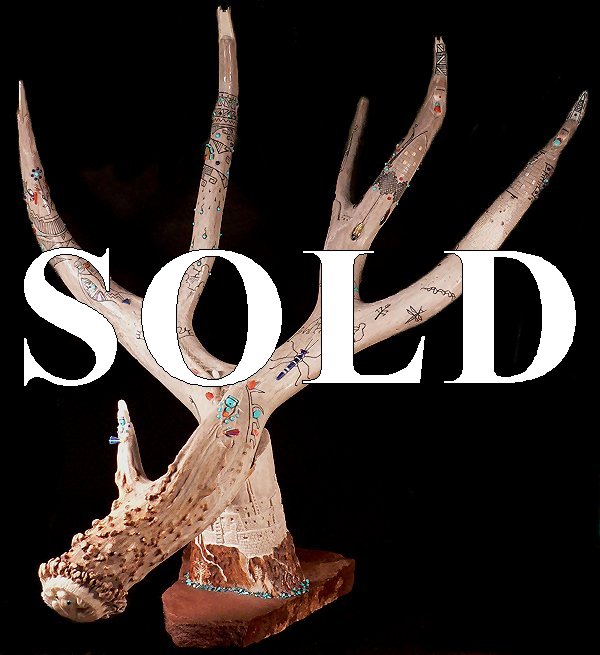"In 2000, a participant in my diabetes research program heard me talking about my interest in acquiring some deer antlers. He was about 60 years old and had been with the research project for about three years. Each Friday for the past three years, I or another staff member would drive out to Pia Mesa to pick him up and return to our offices to conduct our research objectives with him.
Well on one of the Friday trips, he asked if I would personally take him home, he stated that he wanted to give me something. I told him that I could not accept any gifts from him, but he informed me that he wanted to give me something that I was searching for. Upon arrival at his home, he lead me to his old broken down shed, where from on the wall he grabbed an antler which he handed to me. I protested, but he insisted that I take it saying, "You are my son, and I know something wonderful and good will come out of it". He encouraged me to keep that antler intact and to keep him informed of my progress. I left with a big lump in my throat, knowing that I was just given a wonderful gift from one of my participants, a gift that he could have only given to me from his heart.
Well, for a year and a half I concentrated on other pieces leaving the antler alone since I had no idea of what was to come out of the antler. Then in June of 2002, Jackie indicated that we should try to finish a piece for the 2002 New Mexico State Fair. Up until then, we had never done any art shows and didn't know how to enter. With the deadline for entry fast approaching, I started on the first tine of the antler. The first corn maiden (west direction, white corn maiden),the entire rock wall, the wooden ladder, the footholds from the bottom to the base of the ladder, and all the petroglyphs were carved and etched. With the first tine carved, I was sure that the remainder of the antler would follow expediently, but it never happened as planned. In hindsight, I am fortunate that it took this long for me to finish the antler, it gave me the time to determine the theme and carve the various elements associated with it.
Finally, in June of 2006 the final parts were put together to reveal the finished product. Initially, I had a wooden base holding up the antler but the setup was too flimsy, so I had to rethink the base and eventually came up with the antler and sandstone as the pieces for the base.
If one looks at the piece with the burr (end of the antler that connects to the skull) containing the frog, the following stories emerge:
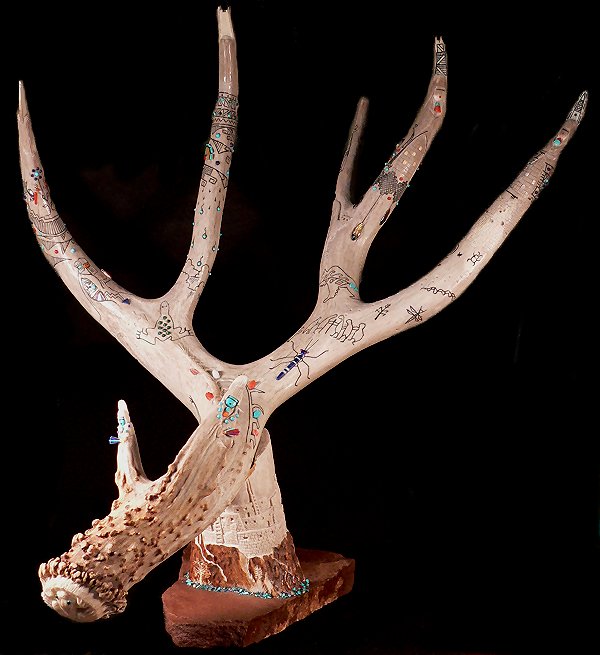
As our legends and migration stories have been told to us, the Zuni People emerged from the fourth underworld in the vicinity of the present-day Grand Canyon. In the fourth world we are described as having slimy skin, long seaweed like hair, horns and tails. This description reminds me of the amphibian world, so I carved a frog at the end of the antler burr to represent this world.
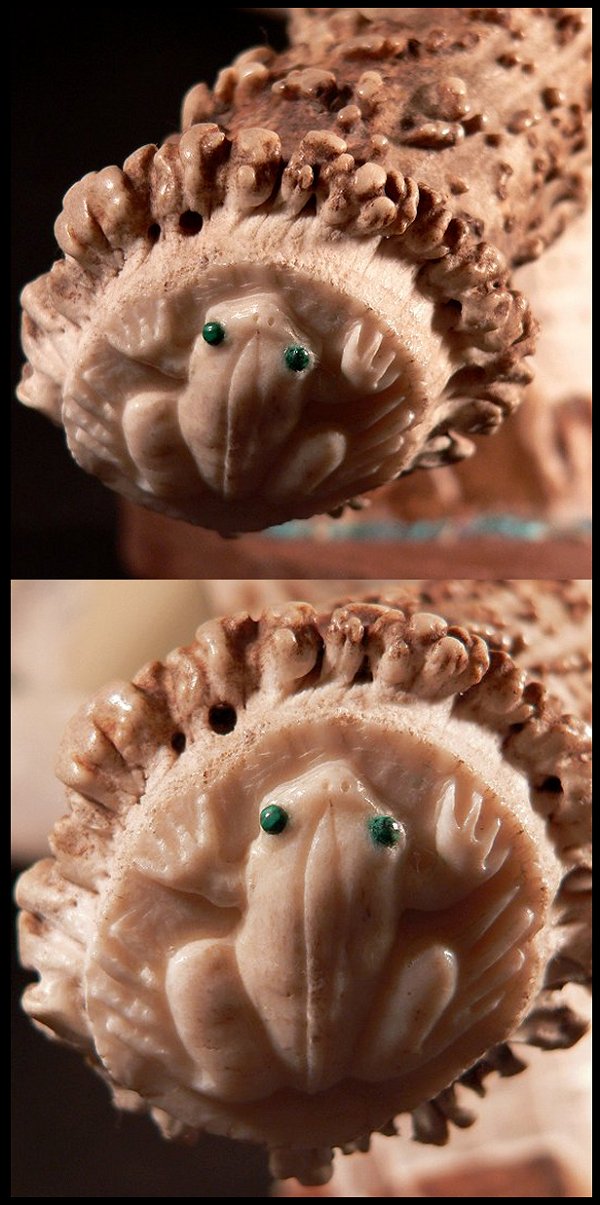
From the burr the next two images that emerge are the two warriors.
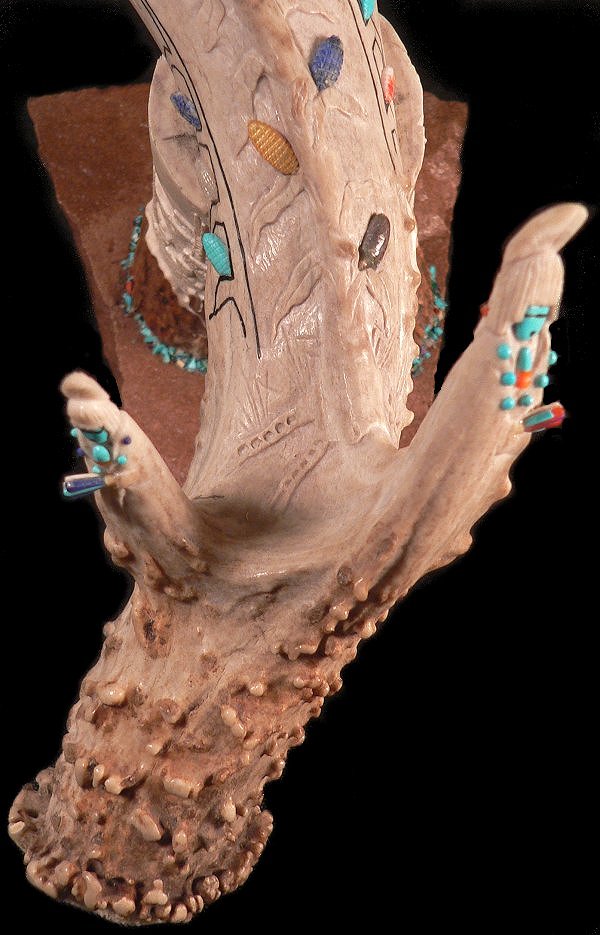
Our stories tell us that it was the two warriors that came into the fourth underworld to assist us in journeying to our present world.

The two warriors are carved out of the two eye guards, dressed in symbolic ribbon shirts, with feathers on their heads, and with the older brother holding a feather fan representative of the Scarlet Macaw, while the younger brother holds the fan representing the Blue and Gold Macaw.

Right behind the two warriors, the four worlds that were transcended through natural ladders are represented by the four ladders representing the roots of the corn stalks.
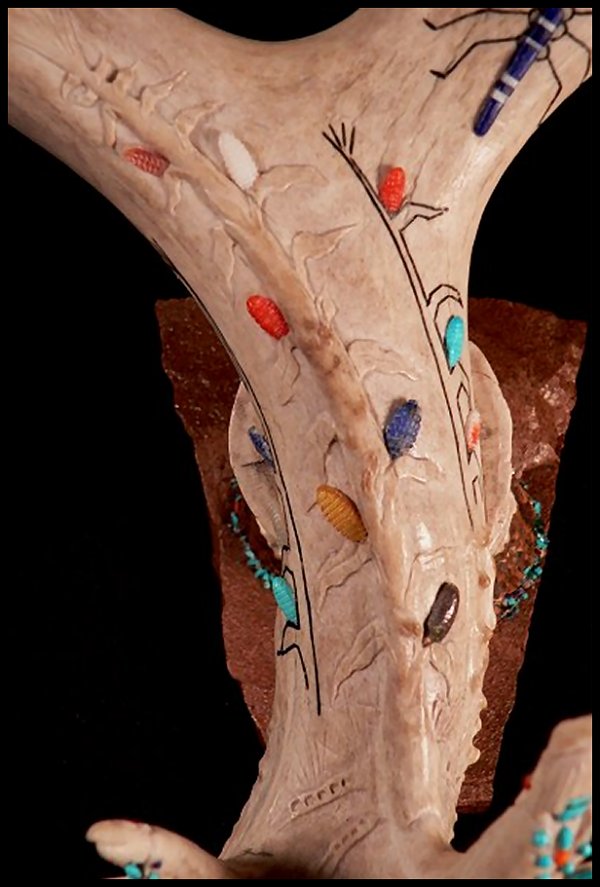
The center corn stalk is representative of the six directions, which are indicated by the six different colored corns.
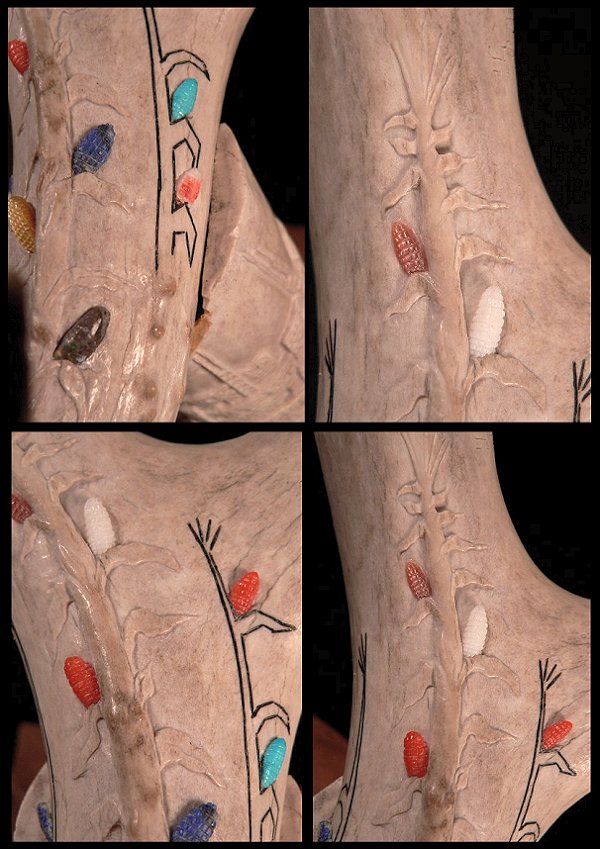
The other two corn stalks are representatives of various tribes that once belonged with the Zuni People, but had to separate and go in a different direction in search of the "center place". We do not know if they ever returned to become part of the Zuni People, thus the corn stalks are not complete.
Moving up the antler, one encounters the water spider. The water spider is an important figure in our migration story, as it was the water spider that located the middle place. Placing its legs to the four bodies of water and then directing the Zuni People to build their village where it's heart touched the ground at "Halonawa".
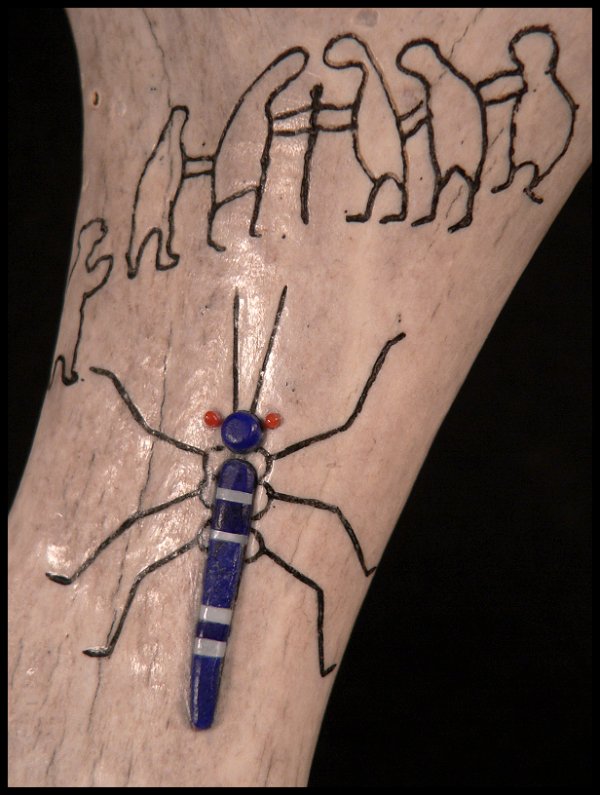
At the confluence of the two main beams, the meeting or separation of the people petroglyph appears. At some point in our journey to the middle place, it was decided that in order to cover more land, the Zuni People had to separate into two bands, one going south with the macaw parrot as their guide and the rest of us heading north under the direction of the crow. As your eyes move towards the right, the bottom of the first tine depicts all the petroglyphs that I could see when I visited the Village of the Great Kivas.
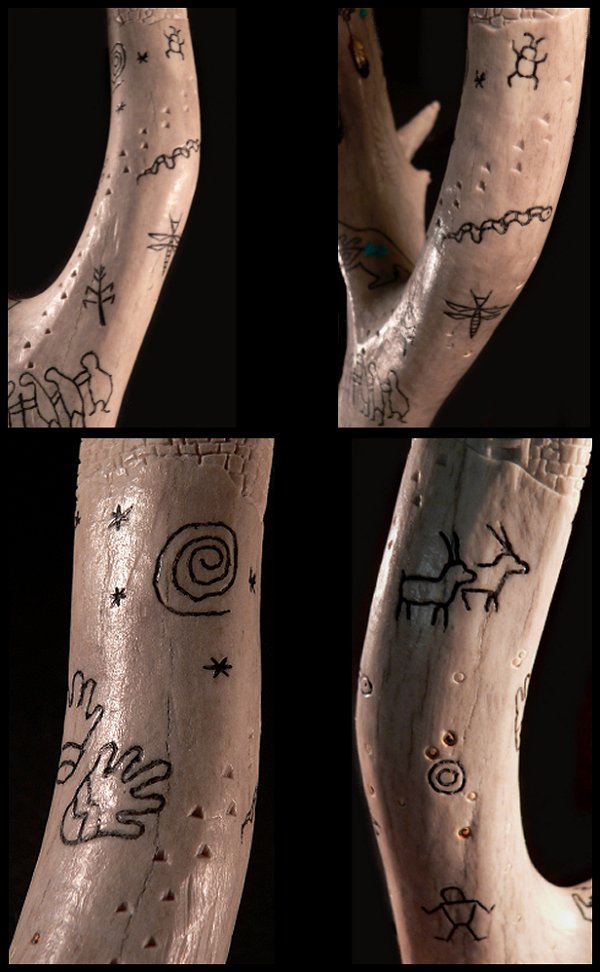
This village was once occupied, but it is remembered for all the wonderful petroglyphs and pictographs that remain, to this day, on the walls of the mesa. I envisioned the village to be on top of the mesa, with footholds leading from the base to the base of the ladder, which extends up the stone wall into the village.

This also reminds me of El Morro, a historical monument east of Zuni (where the village of Atsinna was once occupied by my people) mostly famous for all the stone engraving that the Spanish visitors left on the walls.
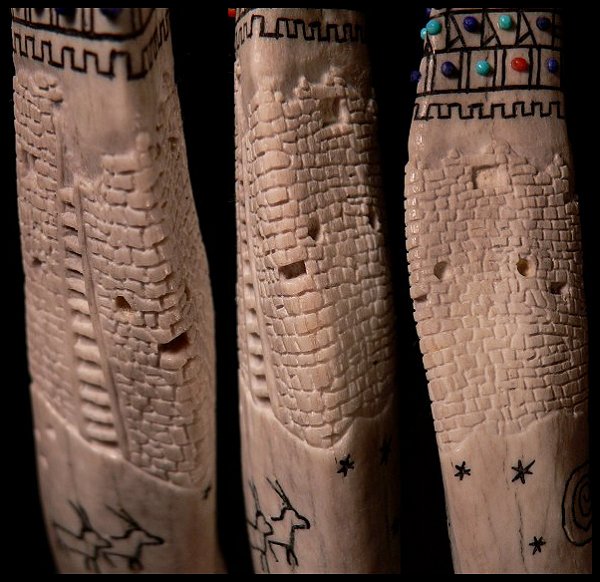
The robe on the maiden is of an older design, with the body engraved in white, to represent the color of the corn for the east direction.

At the base of the next tine to the left, is a stylized bear with a turquoise arrowhead. This followed by a mountain lion descending cautiously from the mountain.

A wolf howling is carved from the smaller tine on the opposite side of the bear,
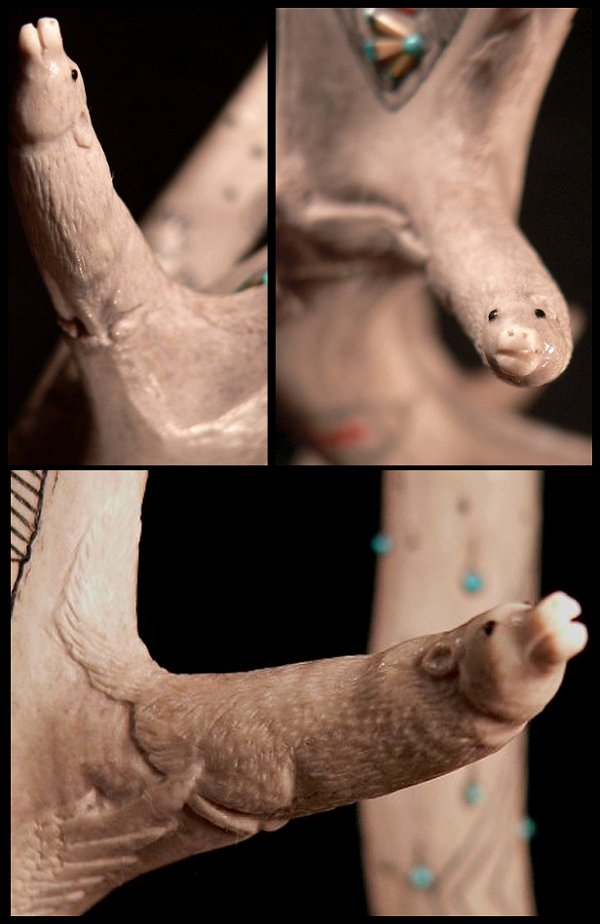
...with an eagle carved in relief next to the wolf.

From the back, one can see the badger, with it's coral heartline

...and the mole with it's coral snout.
The animals depicted here are very important to our lives, as they provide protection and are keepers/guardians of various medicinal plants they are assigned for their directions.
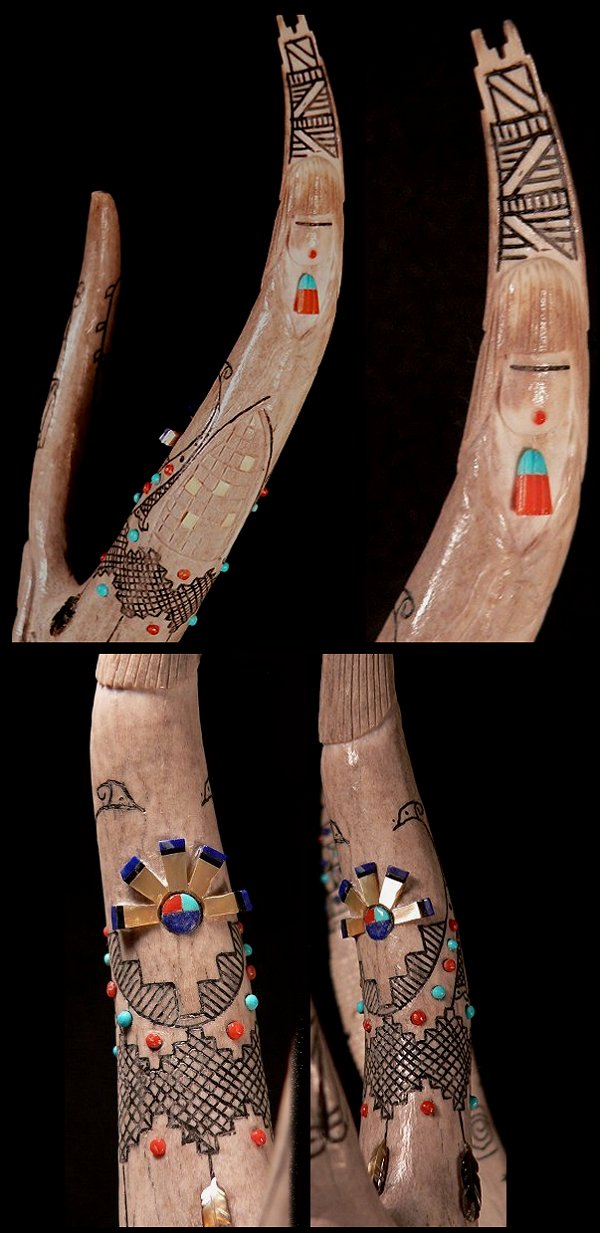
Above the protective animals, the northern corn maiden emerges, with her intricate feathered, pottery designed robe, along with the inlaid sunface surrounded by the rain birds. For me, the north direction is where the two warriors live. This is evident by the Twin Buttes that are on the northern portion of our reservation. The sunface represents the older brother of the two warriors, as the rain birds circling it are enticing the ancestors to provide rain to the Zuni People.
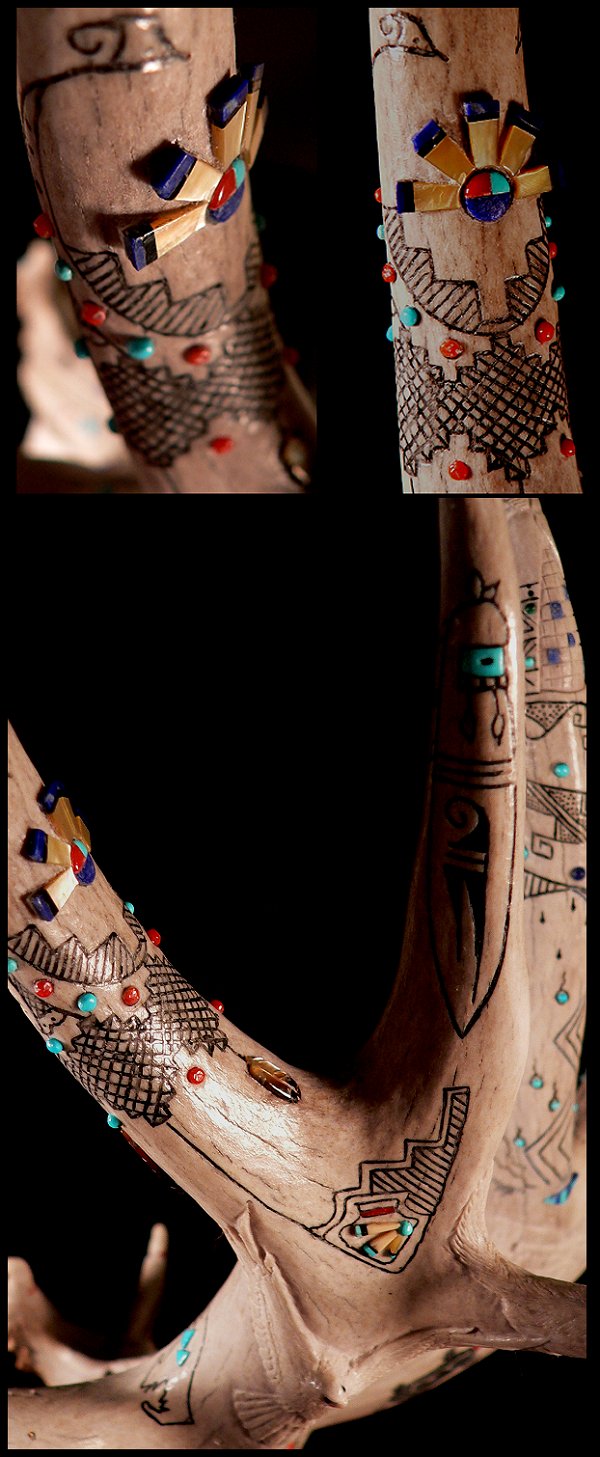
This message can be see by the long line extending from the corn maiden's robe to the pottery that has a stepped design leading to the male and female kachina on the next tine.
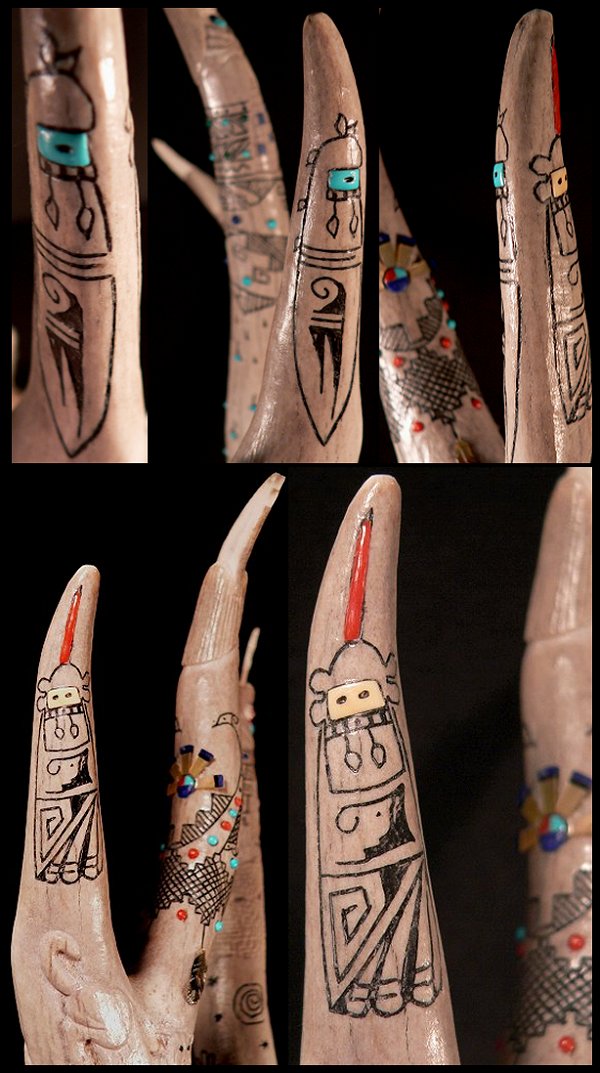
The male rain dancer has the turquoise face, a color associated with the kachina societies, while the female rain dancer has the yellow face, a color associated with Mother Earth. The robes have stylized rain birds etched into the kachinas, another indication of how important rain is to our lives.
As the eyes pan further left, the two remaining tines were carved from the top down.

The first tine has the west corn maiden (lapis inlaid body of corn) standing wrapped by a robe that has various pottery designs associated with different rain elements etched and inlaid into it. Additionally, it has the other sunface, for the younger warrior is inlaid within the robe's design.
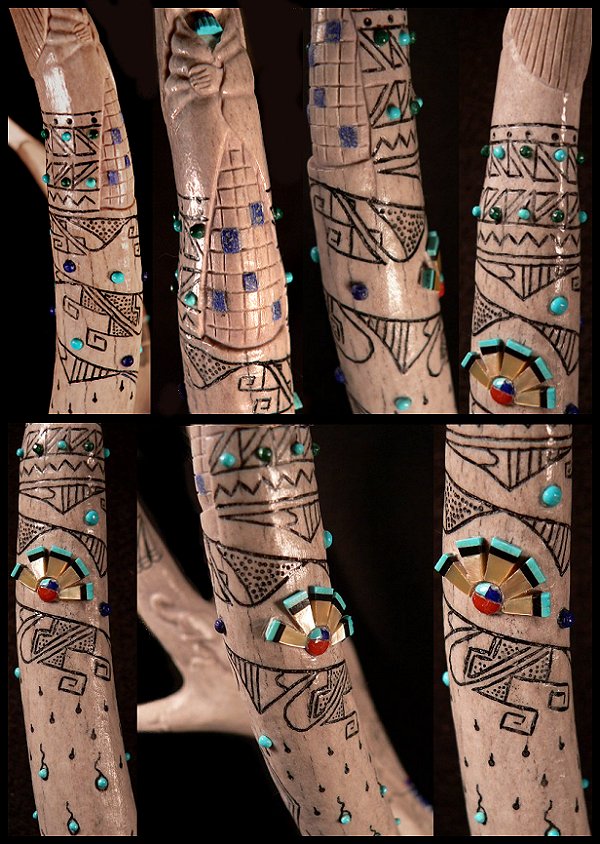
As the design winds down the tine, two differing elements appear. A lighting bolt emerges from the end of the design, on the back side, and is about to strike the village below, as thunderous clouds bellow beside it. On the front side the rain drops (resembling tadpoles) fall onto the village.

I carved the western corn maiden to be the bearer of rain, moisture to the village, since this is generally the direction from which we receive the majority of our moisture.
The last tine to be carved was the south corn maiden.

As with the last corn maiden, she was carved from the top down. She is made to stand within a corn meal bowl, with the dragonfly design etched on the bowl. Her robe is made to represent the importance of all the delicate animals and plants in our lives. Thus, her robe has two butterflies gingerly dancing around a flower, inside another pottery bowl.
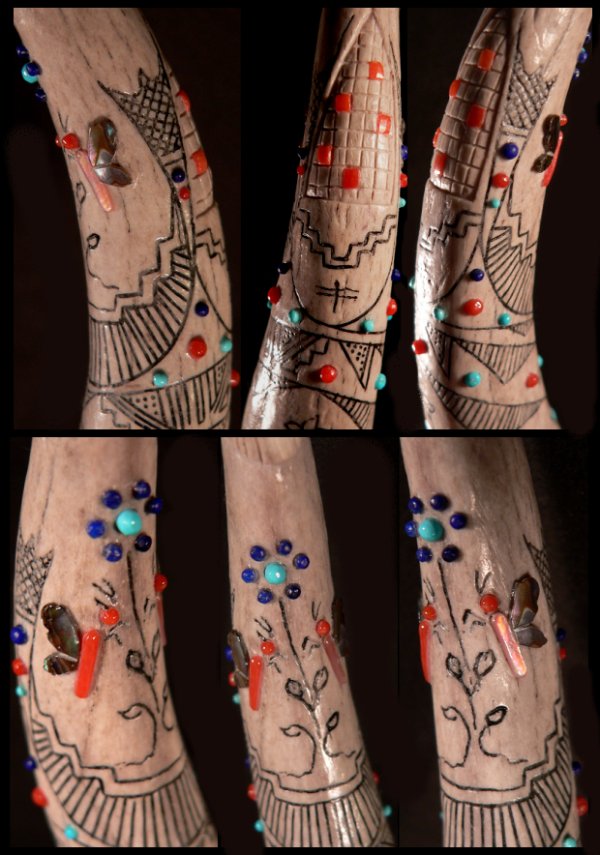
At the bottom of her robe, I etched the Flute Player. As we all know, the flute player is generally associated with the corn maidens, thus he is at his finest playing the flute.
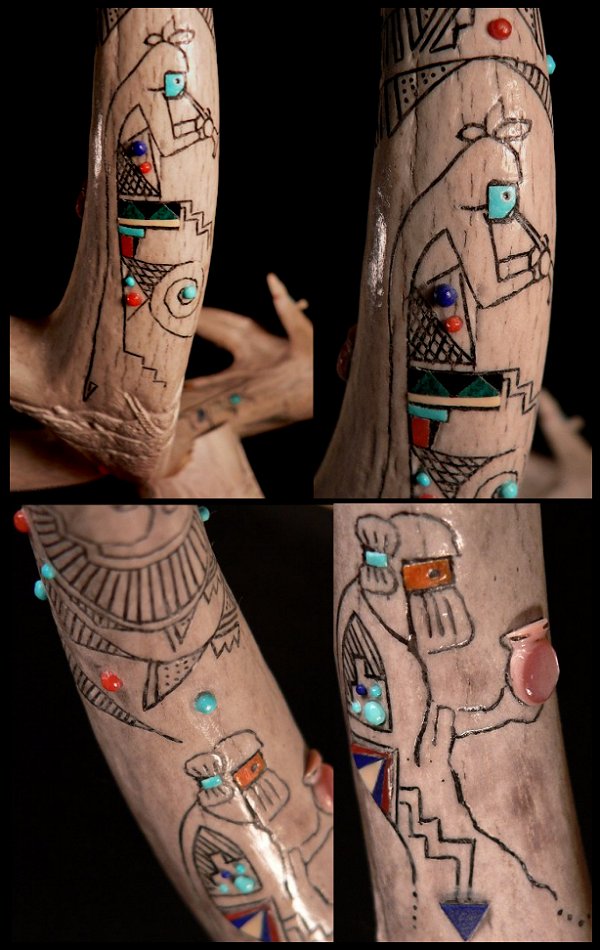
On the other side I added a female kachina in her finest robe, with a water jar/pot, which brings forth blessings, food, moisture and other elements of sustenance to the village below.
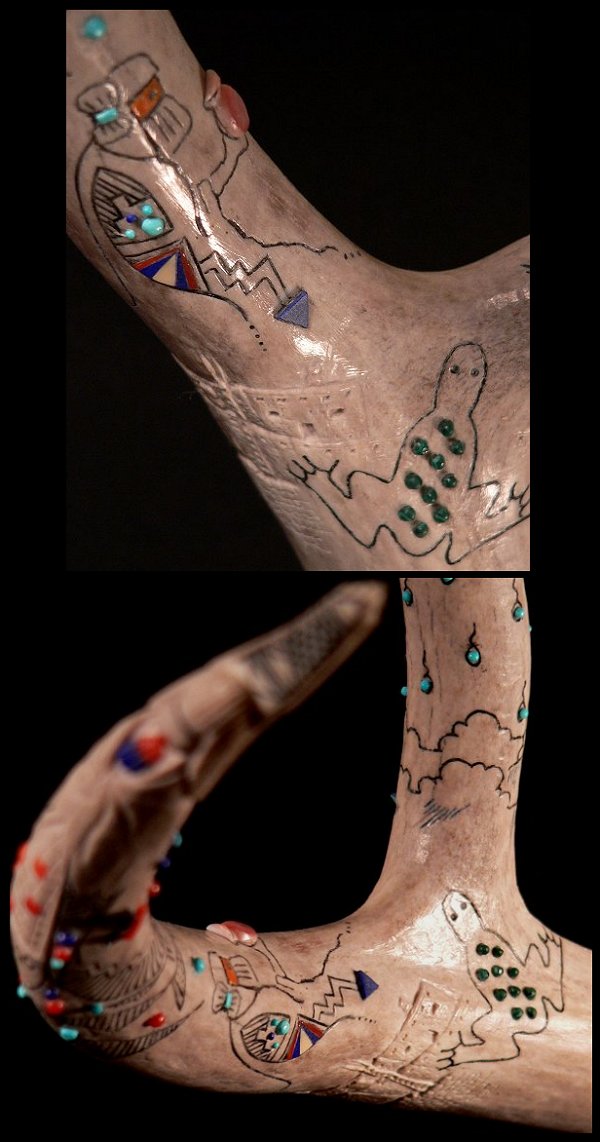
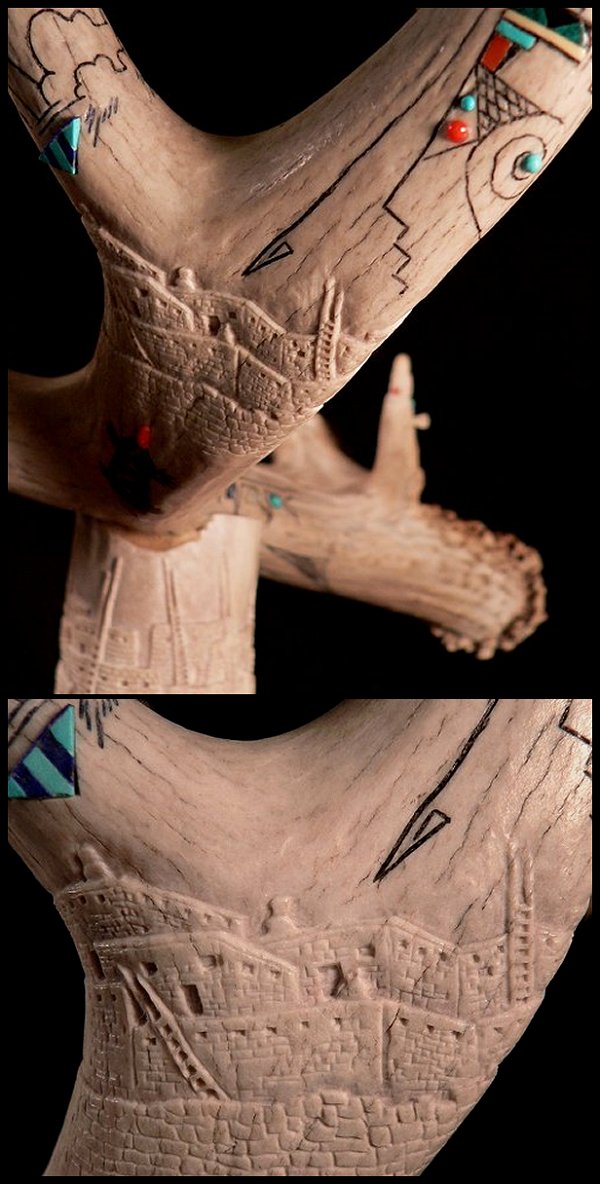
As the story goes, when the men came back from a bountiful hunting trip, they came upon the village with laughing children, but no adult females were alive. The females had given up their sustenance in order for the children to stay alive. At the urging of the elder leader, the men buried the females in a large grave, then with heavy hearts danced the night away. Sometime during the night the Creator sent the Flute Player to play his flute over the grave of the women, but was told not be become emotional. However, knowing how heavy the hearts of the villagers were he could not help himself from shedding some tears as he played. For his disobedience to not show emotion, he was destined to walk around hunched over with a large hump on his back. The female spirits having heard the music, transformed themselves into corn maidens of different colors and are now looked upon to provide corn to the villages of the world, in hopes that no other village will experience the sadness this village had experienced. The long arrows extending from the Flute Player and the female kachina are my interpretation of the blessings that these two figures are bestowing on the village.
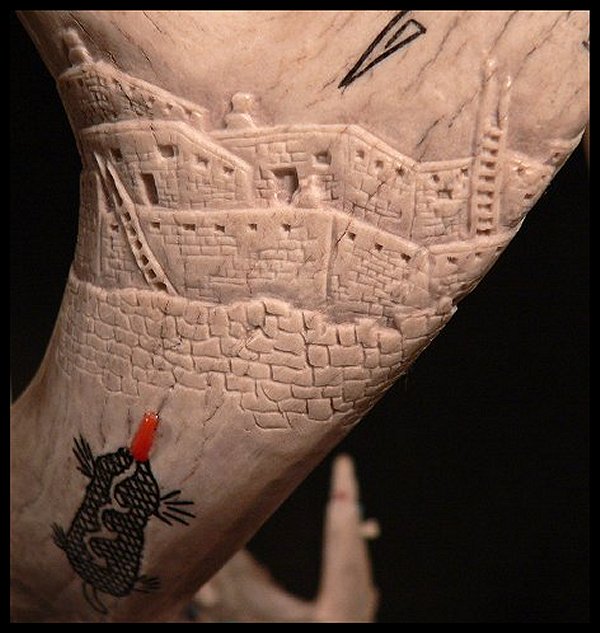
I carved the village at the base of the last two tines one stone at a time. Although this is time consuming, I wanted to make the village look older than the one on the base. This village represents the older villages that have been abandoned, destroyed or excavated since our existence. The ladders are carved to reach the sky, in hopes of piercing the clouds to let the rain fall on the poor frog etched between the village. The frog is another element to relay the importance of rain in our lives and our prayers make reference to all aspects of rain and all other elements of survival.
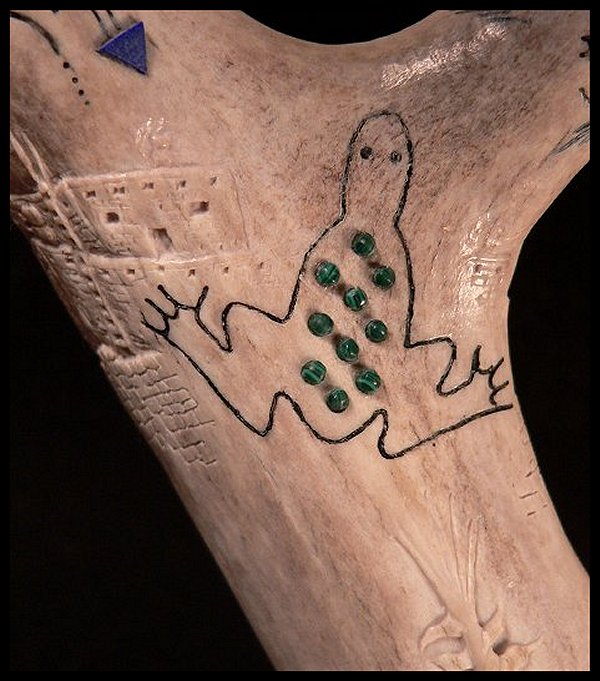
Finally, the base was the last to be put together. I wanted to replace the wooden plaque with something that was sturdy, but also to allow me to carve another village into it. Therefore, I chose to use an elk antler as the base. I carved the bottom to depict
Dowa Yallane (Corn Mountain) with its two protruding twins on the west side and the surrounding mesas.

I etched various plant structures to give the sense of depth to the mountain. On top of the mountain, I carved an entire village, with ladders tall enough to pierce the clouds above, in hopes that moisture will fall upon the village.
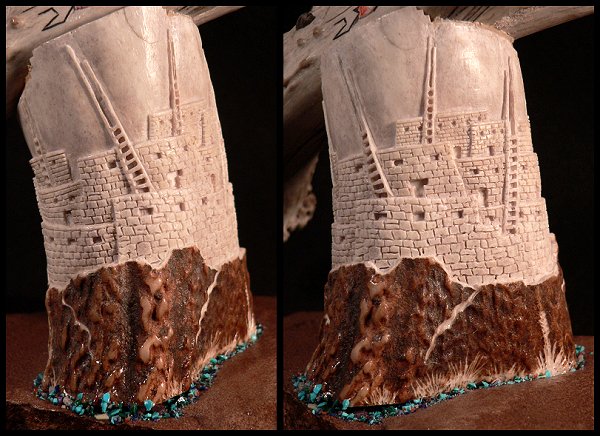

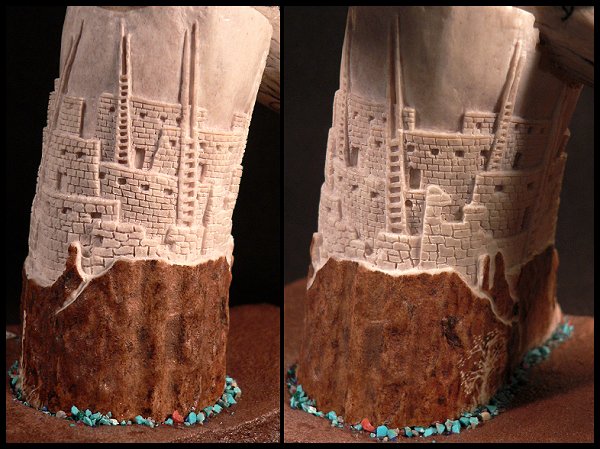
For the bottom of the base, I decided to use the natural sandstone prevalent in construction of Zuni homes. The sandstone is carefully carved by skilled stone workers to yield large blocks that are used as foundations for homes, for use in outdoor ovens, and within the kivas. At the base, where the sandstone meets the antler, I sprinkled some offerings of various semi-precious stones that Jackie utilizes in inlaying our work. In our culture, we are taught to offer cornmeal along with various semi-precious stones to our ancestors, all animals, all plants, and any other form of life that exists in this world. It is our way of saying thanks for all that they have given us, for protecting us, for guiding us and for allowing us to use them and their world to live in.
The title of this piece came about as I was looking at the antler sitting on my work table. I was trying to perceive how I was going to make the antler stand as I wanted it too. Jackie suggested that I leave the entire antler as it would have fallen on the ground, but I wanted it to be elevated at some point to catch the observers eyes to the bottom, where the frog emerges, and where the story starts. After trial and error I finally got the antler standing the way I wanted and as they say the rest is history. While carving the antler, I had to step back several times to make sure the elements were meshing together, but as I looked at it from a distance, only then did I realize that all the intricate elements are hidden until one takes a closer look at the antler. The antler reveals it's secrets as one gets up close and personal with it. Thus, the name for piece emerged, "Secrets Revealed".

La: we (That's All) E:' lah: kwa (Thank you)
- Norman Cooeyate
Price: $12K - SOLD
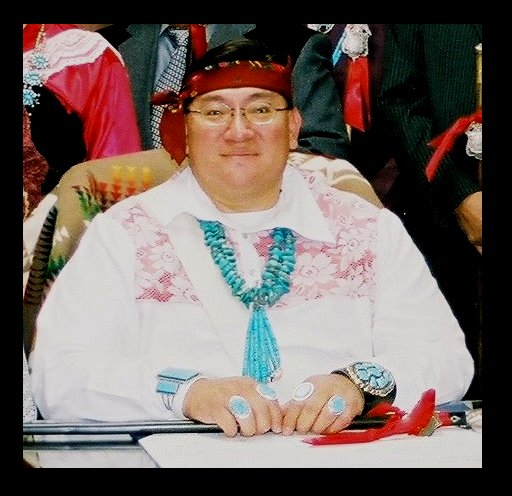
Norman Cooeyate was inaugurated as the Governor of Zuni Pueblo on January 5th of 2007. You may read about the inauguration ceremonies and see photos at this link.



